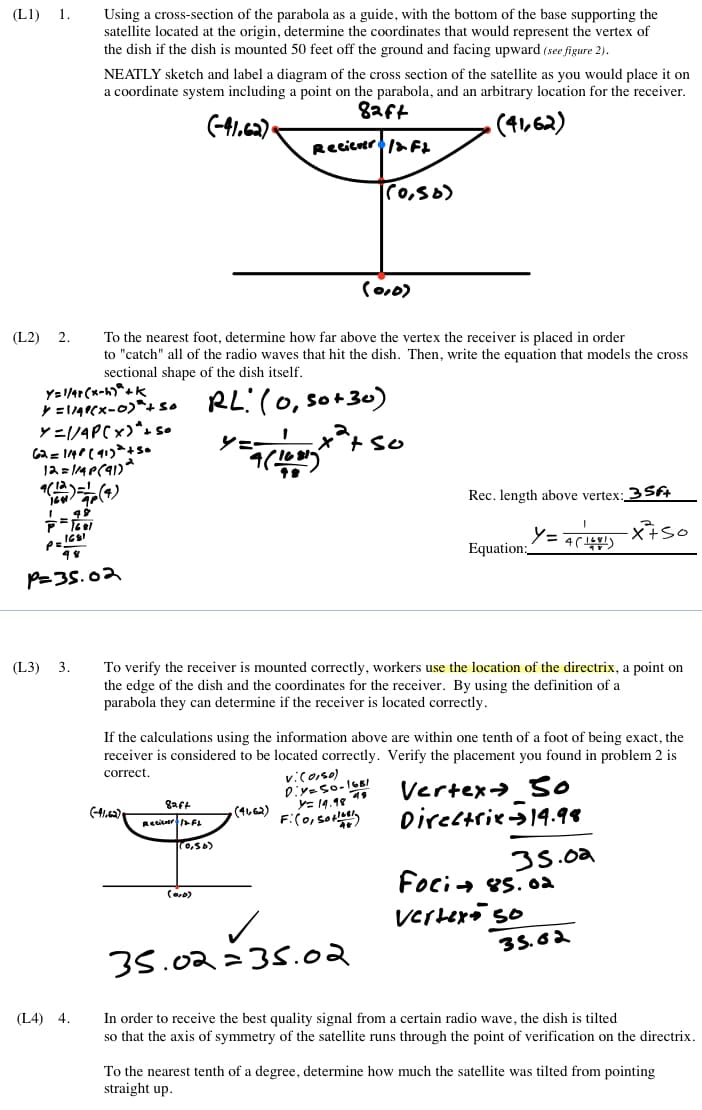To the nearest foot, determine how far above the vertex the receiver is placed in order to "catch" all of the radio waves that hit the dish. Then, write the equation that models the cross sectional shape of the dish itself.
To the nearest foot, determine how far above the vertex the receiver is placed in order to "catch" all of the radio waves that hit the dish. Then, write the equation that models the cross sectional shape of the dish itself.
Algebra and Trigonometry (MindTap Course List)
4th Edition
ISBN:9781305071742
Author:James Stewart, Lothar Redlin, Saleem Watson
Publisher:James Stewart, Lothar Redlin, Saleem Watson
Chapter12: Conic Sections
Section12.FOM: Focus On Modeling: Conics In Architecture
Problem 3P
Related questions
Question
Please answer #4.

Transcribed Image Text:(L1) 1.
Using a cross-section of the parabola as a guide, with the bottom of the base supporting the
satellite located at the origin, determine the coordinates that would represent the vertex of
the dish if the dish is mounted 50 feet off the ground and facing upward (see figure 2).
NEATLY sketch and label a diagram of the cross section of the satellite as you would place it on
a coordinate system including a point on the parabola, and an arbitrary location for the receiver.
8aft
(-41.c2)-
(4,62)
Recicuer/a FL
Co0)
To the nearest foot, determine how far above the vertex the receiver is placed in order
to "catch" all of the radio waves that hit the dish. Then, write the equation that models the cross
sectional shape of the dish itself.
(L2) 2.
Y= 1/4r (x-h)*4k
RL:(0, so+30)
Lx*+ so
Y=1/4PC×)*s s.
シニ
Ja = 14P(91)*
Rec. length above vertex; 3Sft
Equation:
P=35.02
To verify the receiver is mounted correctly, workers use the location of the directrix, a point on
the edge of the dish and the coordinates for the receiver. By using the definition of a
parabola they can determine if the receiver is located correctly.
(L3) 3.
If the calculations using the information above are within one tenth of a foot of being exact, the
receiver is considered to be located correctly. Verify the placement you found in problem 2 is
correct.
vicoiso)
E 19.18 19
F:(0,so
Vertex> O
Directries14.98
gaft
(41.42)
(4662)
Recieer F
(0,56)
35.02
Foci+ es. 0a
verhero so
35.62
35.02=35.02
(L4) 4.
In order to receive the best quality signal from a certain radio wave, the dish is tilted
so that the axis of symmetry of the satellite runs through the point of verification on the directrix.
To the nearest tenth of a degree, determine how much the satellite was tilted from pointing
straight up.
Expert Solution
This question has been solved!
Explore an expertly crafted, step-by-step solution for a thorough understanding of key concepts.
This is a popular solution!
Trending now
This is a popular solution!
Step by step
Solved in 2 steps with 1 images

Knowledge Booster
Learn more about
Need a deep-dive on the concept behind this application? Look no further. Learn more about this topic, calculus and related others by exploring similar questions and additional content below.Recommended textbooks for you

Algebra and Trigonometry (MindTap Course List)
Algebra
ISBN:
9781305071742
Author:
James Stewart, Lothar Redlin, Saleem Watson
Publisher:
Cengage Learning

Algebra & Trigonometry with Analytic Geometry
Algebra
ISBN:
9781133382119
Author:
Swokowski
Publisher:
Cengage

Algebra and Trigonometry (MindTap Course List)
Algebra
ISBN:
9781305071742
Author:
James Stewart, Lothar Redlin, Saleem Watson
Publisher:
Cengage Learning

Algebra & Trigonometry with Analytic Geometry
Algebra
ISBN:
9781133382119
Author:
Swokowski
Publisher:
Cengage